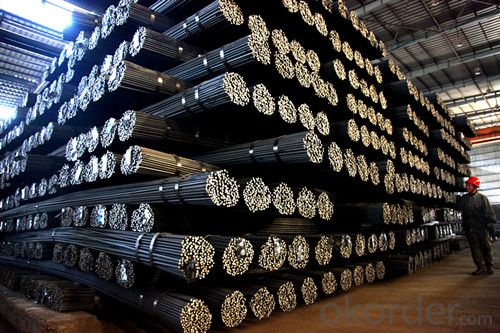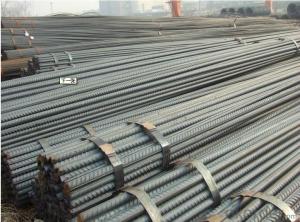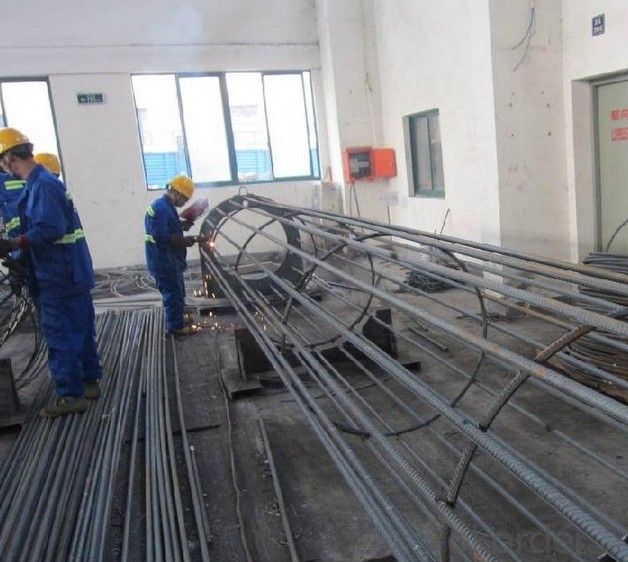Hot rolled high quality deformed bar ASTM A615 GR40
- Loading Port:
- Qingdao
- Payment Terms:
- TT OR LC
- Min Order Qty:
- 25 m.t.
- Supply Capability:
- 20000000 m.t./month
OKorder Service Pledge
OKorder Financial Service
You Might Also Like
Deformed Bar Details:
Product Description:
Specifications of HRB400 Deformed Steel Bar:
Standard | GB | HRB400 | |
Diameter | 6mm,8mm,10mm,12mm,14mm,16mm,18mm,20mm, 22mm,25mm,28mm,32mm,36mm,40mm,50mm | ||
Length | 6M, 9M,12M or as required | ||
Place of origin | Hebei, China mainland | ||
Advantages | exact size, regular package, chemical and mechanical properties are stable. | ||
Type | Hot rolled deformed steel bar | ||
Brand name | DRAGON | ||
Chemical Composition: (Please kindly find our chemistry of our material based on HRB500 as below for your information)
Grade | Technical data of the original chemical composition (%) | ||||||
C | Mn | Si | S | P | V | ||
HRB400 | ≤0.25 | ≤1.60 | ≤0.80 | ≤0.045 | ≤0.045 | 0.04-0.12 | |
Physical capability | |||||||
Yield Strength (N/cm²) | Tensile Strength (N/cm²) | Elongation (%) | |||||
≥400 | ≥570 | ≥14 | |||||
Theoretical weight and section area of each diameter as below for your information:
Diameter(mm) | Section area (mm²) | Mass(kg/m) | Weight of 12m bar(kg) |
6 | 28.27 | 0.222 | 2.664 |
8 | 50.27 | 0.395 | 4.74 |
10 | 78.54 | 0.617 | 7.404 |
12 | 113.1 | 0.888 | 10.656 |
14 | 153.9 | 1.21 | 14.52 |
16 | 201.1 | 1.58 | 18.96 |
18 | 254.5 | 2.00 | 24 |
20 | 314.2 | 2.47 | 29.64 |
22 | 380.1 | 2.98 | 35.76 |
25 | 490.9 | 3.85 | 46.2 |
28 | 615.8 | 4.83 | 57.96 |
32 | 804.2 | 6.31 | 75.72 |
36 | 1018 | 7.99 | 98.88 |
40 | 1257 | 9.87 | 118.44 |
50 | 1964 | 15.42 | 185.04 |
Usage and Applications of HRB400 Deformed Steel Bar:
Deformed bar is widely used in buildings, bridges, roads and other engineering construction. Big to highways, railways, bridges, culverts, tunnels, public facilities such as flood control, dam, small to housing construction, beam, column, wall and the foundation of the plate, deformed bar is an integral structure material. With the development of world economy and the vigorous development of infrastructure construction, real estate, the demand for deformed bar will be larger and larger..
Packaging & Delivery of HRB400 Deformed Steel Bar:
Packaging Detail: products are packed in bundle and then shipped by container or bulk vessel, deformed bar is usually naked strapping delivery, when storing, please pay attention to moisture proof. The performance of rust will produce adverse effect.
Each bundle weight: 2-3MT, or as required
Payment term: TT or L/C
Delivery Detail: within 45 days after received advanced payment or LC.
Label: to be specified by customer, generally, each bundle has 1-2 labels
Trade terms: FOB, CFR, CIF


- Q:Can steel rebars be used in both residential and commercial construction?
- Yes, steel rebars can be used in both residential and commercial construction. They are commonly used to reinforce concrete structures such as foundations, columns, beams, and slabs in both types of construction projects.
- Q:What is the effect of steel rebars on the electrical conductivity of concrete?
- Concrete's electrical conductivity is significantly influenced by steel rebars. The inclusion of steel rebars in concrete enhances its overall electrical conductivity as steel is an excellent conductor. This is because steel rebars create a network of conductive paths within the concrete, facilitating the smooth flow of electrical current. Considering the electrical conductivity of concrete is crucial, particularly in situations that necessitate electrical grounding or conductivity. Steel rebars play a vital role in establishing a low-resistance pathway for electrical current, enhancing the overall electrical conductivity of the concrete structure. Nevertheless, it is important to acknowledge that the presence of steel rebars can pose challenges in certain scenarios. For instance, in electrical installations requiring insulation or areas where electrical isolation is essential, the conductivity provided by steel rebars may not be desired. In such cases, additional measures such as insulation or isolation techniques must be employed to prevent undesired electrical currents from traversing through the concrete. In conclusion, the impact of steel rebars on the electrical conductivity of concrete is contingent upon the specific requirements and applications of the concrete structure. A thorough understanding of the intended use and the implementation of appropriate measures will ensure that the electrical conductivity of the concrete meets the desired specifications.
- Q:What are the typical costs associated with using steel rebars in a construction project?
- The costs of utilizing steel rebars in a construction venture can differ based on various elements. These elements incorporate the size and type of the rebar, the amount required, the market conditions, and the project's location. Typically, the expense of steel rebars is calculated per ton or per linear foot. The cost per ton can fluctuate between $400 and $600, while the cost per linear foot can range from $0.75 to $1.50. It is important to note that these prices are approximate and subject to change based on market demand and availability. Furthermore, there might be additional expenses related to the acquisition and handling of steel rebars. These expenses can include transportation fees, storage costs, and the necessary equipment or tools required for installation. Other cost considerations may involve labor costs for cutting, bending, and placing the rebars, as well as any reinforcement detailing required according to the project's design specifications. These costs can vary depending on the project's complexity and the skill level of the laborers involved. It is also crucial to account for any potential wastage or scrap materials that may arise during the construction process. Proper planning and accurate measurements can help minimize these costs. In general, the typical costs connected with utilizing steel rebars in a construction project can be substantial, but they are necessary to ensure structural integrity and reinforcement. It is advisable to obtain quotes from multiple suppliers and contractors to ensure competitive pricing and carefully consider the project's specific requirements before finalizing the budget.
- Q:What are the common applications of steel rebars in construction?
- Steel rebars are commonly used in construction for reinforcing concrete structures such as buildings, bridges, and highways. They provide strength and stability to the concrete, enhancing its load-bearing capacity and resistance to tension and bending forces. Additionally, steel rebars help prevent cracks and structural failures in the concrete, ensuring the longevity and durability of the construction project.
- Q:What is the impact of steel rebars on the overall carbon footprint of a building?
- Steel rebars have a significant impact on the overall carbon footprint of a building. The production of steel involves high energy consumption and releases a substantial amount of greenhouse gas emissions, primarily carbon dioxide. The extraction and processing of iron ore, as well as the manufacturing and transportation of steel rebars, contribute to the carbon footprint of a building. The carbon footprint of steel rebars is further influenced by the extent of the rebar usage in the building. The more steel rebars used, the higher the carbon footprint will be. The size and complexity of the structure, as well as the specific design requirements, will determine the quantity of steel rebars needed. However, it is important to note that steel rebars are an essential component of reinforced concrete, which is widely used in construction due to its strength and durability. Reinforced concrete provides structural integrity and ensures the safety and longevity of a building. So, while steel rebars contribute to the carbon footprint, they also play a crucial role in constructing safe and resilient structures. To mitigate the carbon footprint associated with steel rebars, several strategies can be employed. One approach is to use recycled steel rebars, which significantly reduces the energy consumption and emissions associated with steel production. Additionally, optimizing the design and construction process can help minimize the overall amount of steel required, thereby reducing the carbon footprint. Moreover, alternative materials such as fiber-reinforced polymers (FRPs) are being developed as substitutes for steel rebars. FRPs have lower carbon footprints, as they are made from materials such as fiberglass or carbon fiber, which have lower emissions during production. However, the use of FRPs is still limited, and further research and development are needed to increase their viability as a mainstream alternative. In conclusion, steel rebars have a notable impact on the overall carbon footprint of a building due to the energy-intensive production process and emissions associated with their extraction, manufacturing, and transportation. However, their crucial role in providing structural integrity and durability must be considered. Efforts to reduce the carbon footprint of steel rebars include using recycled materials, optimizing designs, and exploring alternative materials such as FRPs. Ultimately, a holistic approach that considers both the environmental impact and the structural requirements of a building is necessary to minimize the carbon footprint associated with steel rebars.
- Q:What is the ductility of steel rebars?
- Steel rebars are capable of deforming and stretching without fracturing while under tension or bending, which is what ductility refers to. The excellent ductility exhibited by steel rebars enables them to effectively absorb and disperse energy when exposed to heavy loads or seismic forces. This attribute is crucial in construction as it guarantees that the rebars can endure harsh conditions while maintaining the structural integrity. Additionally, the ductility of steel rebars renders them suitable for numerous applications, including reinforcing concrete structures and providing support for buildings, bridges, and other infrastructure projects.
- Q:How do steel rebars resist fire?
- Steel rebars resist fire due to their high melting point and low thermal conductivity. Steel has a melting point of around 1370°C, which is higher than typical temperatures reached in building fires. This allows rebars to maintain their structural integrity even in high-temperature environments. Additionally, steel has a low thermal conductivity, meaning it does not readily transfer heat, minimizing the risk of fire spread and structural failure. The combination of these properties makes steel rebars a reliable choice for reinforcing concrete structures in fire-prone areas.
- Q:What is the difference between rebar bolts and steel bars?
- This question can only be answered: "material should not be compared to components.". Insist on saying the difference, one is the material, and the other is the component.You may ask the difference between soil nail and anchor bar, but the topic is not. I shall be glad to answer another question!
- Q:What is the importance of proper anchoring of steel rebars in concrete?
- Proper anchoring of steel rebars in concrete is of utmost importance as it ensures structural integrity and enhances the overall strength and durability of the concrete structure. The anchoring process securely holds the rebars in place, preventing them from shifting or slipping under various loads and stresses. This, in turn, helps in maintaining the desired design strength, resisting cracking, and providing adequate reinforcement to withstand external forces such as earthquakes, wind, and other dynamic loads. In essence, proper anchoring of steel rebars is critical in ensuring the long-term stability and safety of concrete structures.
- Q:High strength thread steel hrb400e 32 in diameter, is it special steel?
- Hrb400e diameter 32 of the rebar is not special steel, it is seismic steel.
1. Manufacturer Overview |
|
|---|---|
| Location | |
| Year Established | |
| Annual Output Value | |
| Main Markets | |
| Company Certifications | |
2. Manufacturer Certificates |
|
|---|---|
| a) Certification Name | |
| Range | |
| Reference | |
| Validity Period | |
3. Manufacturer Capability |
|
|---|---|
| a)Trade Capacity | |
| Nearest Port | |
| Export Percentage | |
| No.of Employees in Trade Department | |
| Language Spoken: | |
| b)Factory Information | |
| Factory Size: | |
| No. of Production Lines | |
| Contract Manufacturing | |
| Product Price Range | |
Send your message to us
Hot rolled high quality deformed bar ASTM A615 GR40
- Loading Port:
- Qingdao
- Payment Terms:
- TT OR LC
- Min Order Qty:
- 25 m.t.
- Supply Capability:
- 20000000 m.t./month
OKorder Service Pledge
OKorder Financial Service
Similar products
New products
Hot products
Related keywords






























